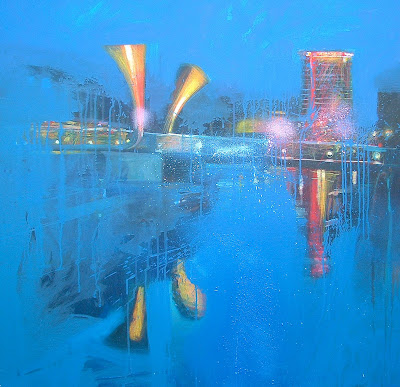
Montana Gold Tests by Glyn Macey
GRAFFITI
1984, I am fourteen, and I have just acquired a copy of Martha Cooper and Henry Chalfant’s seminal book Subway Art.
The first book to really focus on the New York subway graffiti artists.
The book is a revelation, no more than that, the book is an inspiration.
An inspiration that completely and utterly transforms the way I work.
Overnight I change from a boy of fourteen painting pseudo Newlyn School copies during my lunch break at school, into a fourteen-year-old graffiti maniac.
Now I’m not talking the lazy, scruffy and often offensive graffiti that is scrawled on every available surface in every town centre; no; I am referring to the beautifully designed, creatively made pieces; the town centre enhancing pieces.
The pieces that abound with exuberant colour and spray can expertise.
I spend the next two or three years terrorising Penzance with my midnight graffiti efforts, the results of which often appeared in the pages of the local newspaper.
Of course good old Penzance bus depot isn’t quite the New York Subway system but my intentions were the same, regardless of location.
Skip forward twenty-five years and apart from a few old Polaroid’s, my graffiti days are well behind me and almost completely forgotten.
Forgotten that is until I am sent a big box of juicy Montana Gold Acrylic Spray paints.
Unpacking the box, feeling the weight of the cans, hearing the jangle of the bearing inside and checking the various nozzles brought it all flooding back.
I resist the urge to creep out of the house at two in the morning and brighten up the local bus depot once more and instead wonder how I can experiment with these cans in a way that will show them off to their full potential?
I decide to paint a cityscape using traditional methods stirred up with my usual unconventional methods all topped off with a frothy topping of my old graffiti techniques.
The city I choose to depict is one that I know well, and coincidentally is also the original home of Banksy, graffiti artist par excellence; Bristol.
PAINTING
The first thing that strikes me about the Montana Gold range is the huge, and I mean really huge range of colours.
Over 200 glorious colours winking at me from the colour chart poster, “Go on Glyn, buy me, shake me, spray me” the colours tempt, “You know you want to!”
And I do.
I try and trick the colour chart by searching for shades and tints that I might one day like to use, shades and tints that I think might be missing; but they are all there, every last one, all available, and all in a spray can.
And where else do you find a colour range that includes the delightfully named Banana Joe, Make-Up, Scampi, Vampirella, Mt. Everest, Brain, Poison and who could resist Dirty Apricot?
So, the first test is passed with flying colours.
Next I study the application process and find the expected, ‘Danger! Extremely Flammable, Contents Under Pressure, Vapour Harmful, don’t inhale, spray on your skin or use as an ice cream topping usual warnings, so, OK, maybe Montana Gold Acrylic Spray Paint isn’t one for the kiddies but when using all your common sense safe practices these cans are awesome.
Next, I am slightly suspicious of the Extremely High-covering claim and try working light over dark, but the covering doesn’t let me down, it does indeed cover well and the paint dries quickly too, which is a real help when trying to avoid the dreaded drips of conventional spray cans.
So what next?
The literature states ‘CFC free’, I should think so to, ‘Low-Pressure system works on flexible surfaces’, and it does; ‘Weatherproof and lightproof’, again, tick, yes it does; and finally ‘High Accuracy’, yes, absolute high accuracy, if you want it; or if you want broader strokes, larger areas covered and other special effects you can simply pop on the relevant fat, skinny or inbetweeny cap.
Oh, and did I say that the acrylic paint is Matt which is perfect for over painting but also comes in Gold’s, Coppers, Silvers, pure Magentas, Cyan’s and Yellows; as well as every subtle shade imaginable from Pebble, Malachite and Elm to the dazzling Gleaming Pink.
Now I can’t guarantee that these cans will turn you into the new Banksy but they will open your eyes to new ways of working and that surely can only be a good thing.












